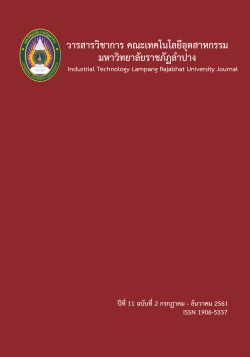Characterization of Gluta Usitata Sap and Adhesion on Ceramic Surface
Keywords:
Lacquer Sap, Gluta Usitata, Lacquer Ware, Varnish, ThitsiolAbstract
This research aimed to study the characteristics and behavior of adhesion of Gluta Usitata sap on ceramic surface. For use in decorating materials on ceramic products, its chemical composition and structure were studied using FTIR (Flourier Transform Infrared Spectrometry) and GC/MS (Gas Chromatography and Mass Spectrometry, GC/MS). It was found that catechol (C6H4(OH)2) linked with aliphatic molecule in the form of Heptadecenylcatechol compound was a major composition of sap corresponding to thitsiol monomer. In addition, water was found to a level of around 40%. The physical characteristics of sap in terms of density, viscosity, and hardening time were 0.98 g/cm3, 4,057 mPas, and 14 days respectively. The wetting and adhesion to ceramic surface between 700 - 1200oC firing temperatures was studied. It was found that increasing the wetting meant increasing the firing temperature due to lower porosity. However, Kerosene was used for reducing the viscosity in the lower contact angle or increasing the wetting using high kerosene content. The optimum adhesion of sap on ceramic surface was found at 700oC firing temperature compared to the other temperatures with higher porosity and higher adsorption.
References
ASTM D1200. 1994. Standard Test Method for Viscosity by Ford Viscosity Cup.
ASTM D3359. 2009. Standard Test Methods for Measuring Adhesion by Tape Test.
Frade, J. C., Ribeiro, M. I., Graça, J. and Rodrigues, J. (2009). Applying pyrolysis-gas chromatography/mass spectrometry to the identification of oriental lacquers: study of two lacquered shields, Analytical and Bioanalytical Chemistry, 39, 2167–2174.
Frade, J. C., Ribeiro, I., Graca, J., Vasconcelos, T. and Rodrigues, J. (2010). Chemotaxonomic application of Py-GC/MS: Identification of lacquer trees. Analytical and Applied Pyrolysis, 89, 117–121.
Honda, T., Lu, R., Sakai, R., Ishimura, T. and Miyakoshi, T. (2008). Characterization and comparison of Asian lacquer saps, Progress in Organic Coatings, 61, 68–75.
Kiprop, A. K., Pourtier, E. and Kimutai, S. K. (2013) GC-MS and ESI-MS detection of catechol, International Journal of Education and Research, 1(12), 1-12.
Lu, R., Harigaya, S., Ishimura, T., Nagase, K. and Miyakoshi, T. (2004). Development
of a fast drying lacquer based on raw lacquer sap, Progress in Organic Coatings, 51, 238–243.
Lu, R., Kamiya, Y., and Miyakoshi, T. (2007a). Preparation and characterization of Melanorrhoea usitata lacquer film based on pyrolysis–gas chromatography/mass spectrometry, Analytical and Applied Pyrolysis,
78, 172–179.
Lu, R., Kamiya, Y. and Miyakoshi, T. (2007b) Characterization of lipid components of Melanorrhoea usitata lacquer sap, Talanta, 71, 1536–1540.
Lu, R., Harigaya, S., Ishimura, T., Nagase, K. and Miyakoshi, T. (2004). Development of a fast drying lacquer based on raw lacquer sap, Progress in Organic Coatings, 51, 238–243.
Lu, R., Miyakoshi, T., (2015). Lacquer Chemistry and Applications: Modification of lacquer, ISBN: 978-0-12-803589-4, Elsevier, 171-214.
Wan, Y.-Y., Lu, R., Yu-Min Du, Y.-M., Honda, T. and Miyakoshi, T. (2007). Does Donglan lacquer tree belong to Rhus vernicifera species? International Journal of Biological Macromolecules, 41, 497–503.
Wangchareontrakul, S. (2007). Seminar on Study of Oriental Lacquer Initialed by H.R.H. Princess Maha Chakri Sirindhorn for the Rovitalization of Thai Wisdom, September 17-19, Bangkok : Amarin Printing and Publishing. (in Thai)
Webb, M., (2000). Lacquer: Technology and conservation. ISBN: 978-075-06-4412-9, Oxford : Butterworth-Heinemann, 6.






